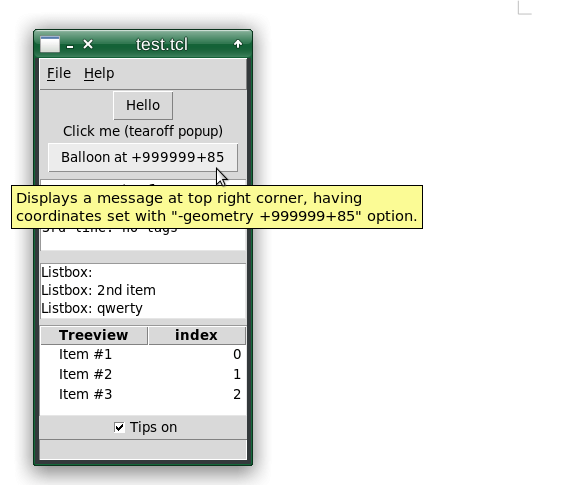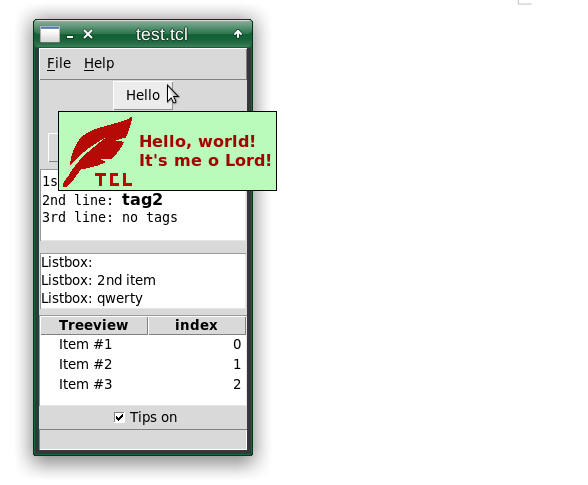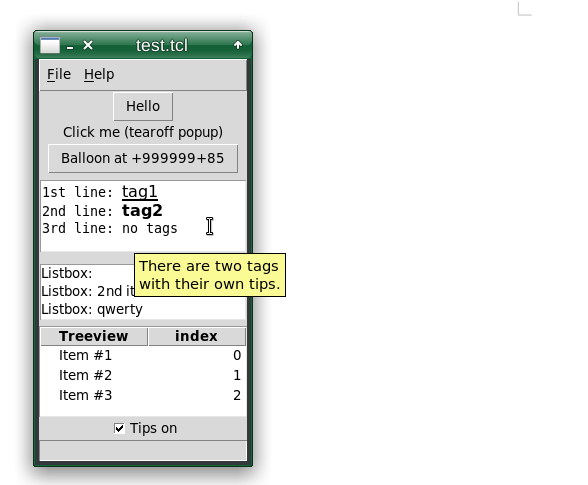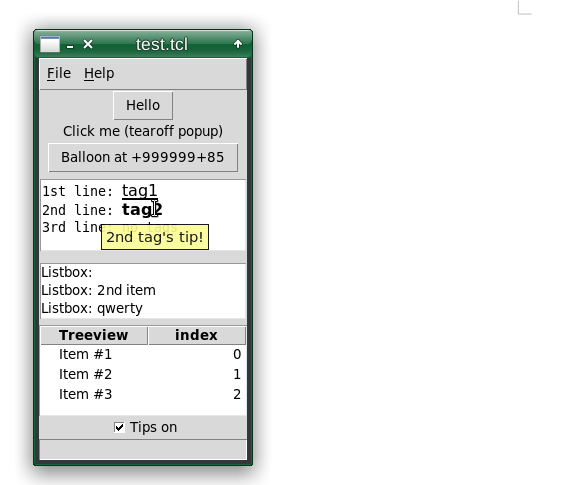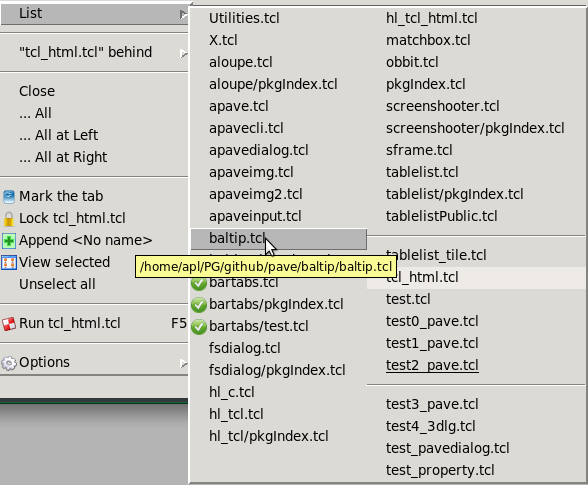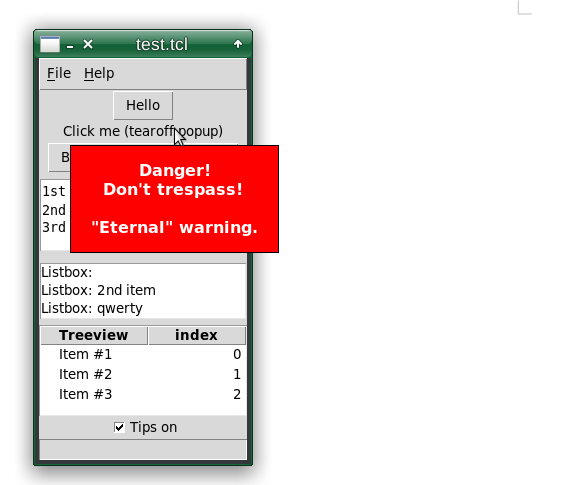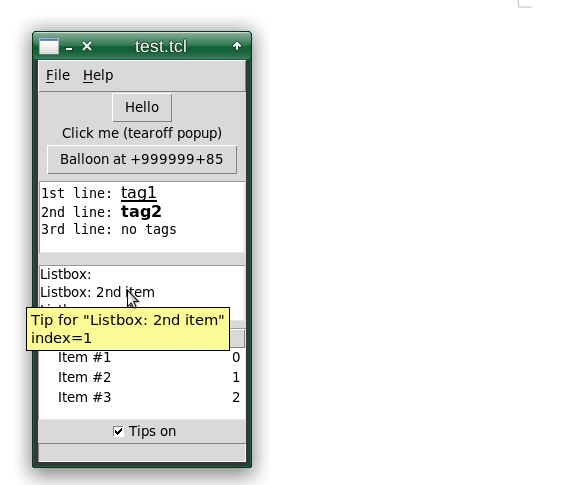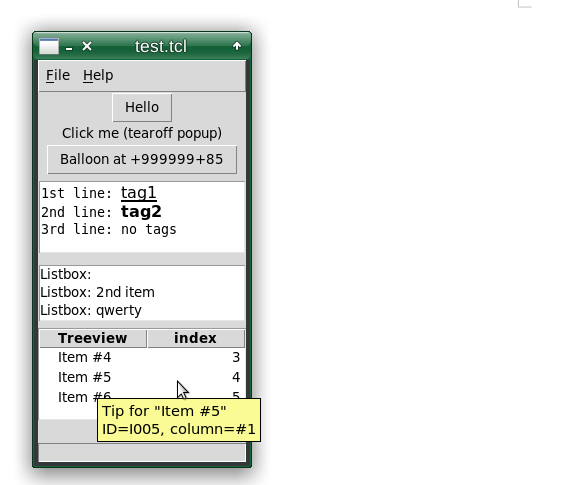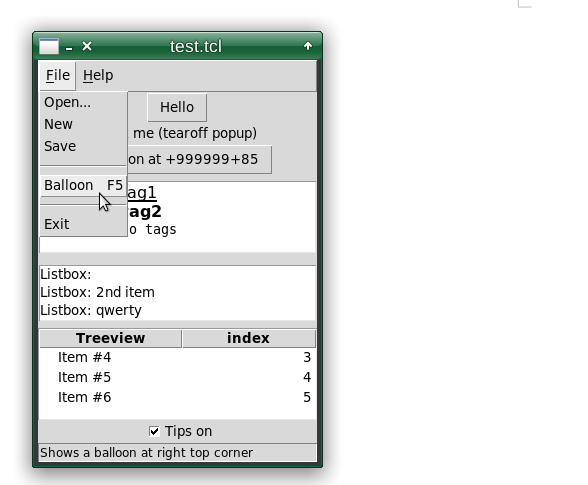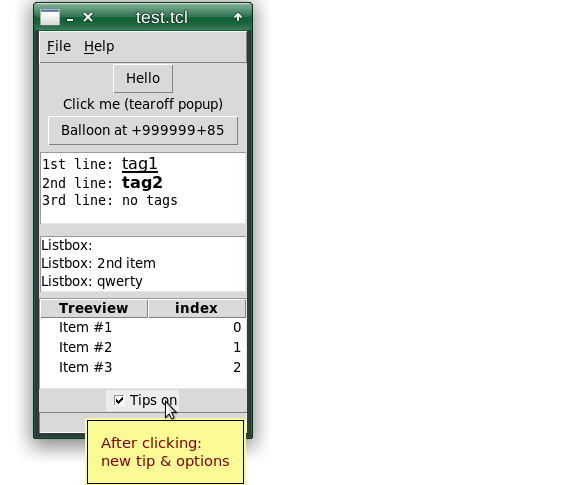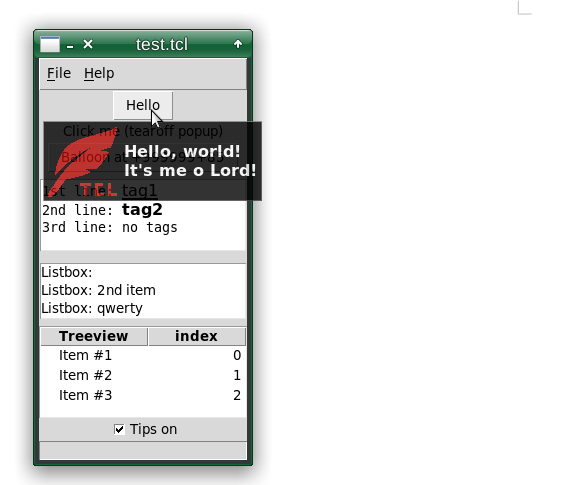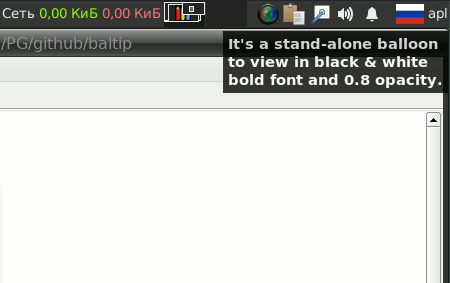It's a Tcl/Tk tip widget inspired by:
The original code has been modified to make the tip:
- be faded/destroyed after an interval defined by a caller
- be enabled/disabled for all or specific widgets
- be disabled for a while ("sleep")
- be usable with labels, menus, text/canvas tags, notebook tabs, listbox/treeview items etc.
- be displayed at the screen's edges
- be displayed under the host widget
- be displayed with a shift (on X and Y) relative to the mouse pointer
- be displayed as a stand-alone balloon message at given coordinates
- be displayed with given font, colors, paddings, border, relief, opacity, bell
- have
-imageand-compoundoptions to display images - have
-commandoption to be displayed in a status bar instead of a balloon - have
-commandoption to be changed dynamically, with each tip's exposition - have
-maxexpoption to limit the number of tip's expositions - have configure/cget etc. wrapped in Tcl ensemble for convenience
The video introduction to baltip is presented by baltip-1.3.1.mp4 (17 Mb).
Below are several pictures just to glance at baltip.
Under the mouse pointer. By default, the tips are displayed just under the mouse pointer.
Under the widget. This button's tip is configured to be just under the button. As well as the text's tip. This feature is well fit for widgets positioned in a row (e.g. in toolbar, tabbar etc.).
Tips of text tags. The text tags can have their own tips.
The tags of canvas have tips too.
Tips of menu items. The menu items can have their own tips. The popup menus may be tear-off at that.
The menu tips are useful e.g. when the items are displayed as short names, while the tips are wanted to be full names.
Label of danger. The labels are also tipped. This one is configured to be an alert shown "eternally" (i.e. till hovering over it).
The tabs of notebook are also supplied with tips.
The listbox can have tips per item as well as for a whole listbox widget.
The ttk::treeview can have tips per item and/or column as well as for a whole treeview widget.
The -command option allows to display tips in a status bar instead of a balloon.
Configurable tips. The tip configuration can be global or local (for a specific tip).
The configuring can include: font, colors, paddings, border, relief, exposition time, opacity, image (with -compound option), bell.
Balloon. The balloon messages aren't related to any widgets. This one is configurated to appear at the top right corner, disappearing after a while.
The baltip usage is rather straightforward. Firstly we need package require:
lappend auto_path "dir_of_baltip"
package require baltip
Then we set tips with ::baltip::tip command for each appropriate widget:
::baltip::tip widgetpath text ?-option value?
# or this way:
::baltip tip widgetpath text ?-option value?
For example, having a button .win.but1, we can set its tip this way:
::baltip tip .win.but1 "It's a tip.\n2nd line of it.\n3rd."
To get all or specific settings of baltip:
::baltip::cget ?-option?
# or this way:
::baltip cget ?-option?
To get a specific widget's tip option:
::baltip::cget widgetpath -option
# or this way:
::baltip cget widgetpath -option
To set some options:
::baltip::configure -option value ?-option value?
# or this way:
::baltip config -option value ?-option value?
To set a specific widget's tip option:
::baltip::configure widgetpath -option value ?-option value?
# or this way:
::baltip config widgetpath -option value ?-option value?
Note: the options set with configure command are global, i.e. active for all tips.
The options set with tip command are local, i.e. active for the specific tip.
To disable all tips:
::baltip::configure -on false
To disable some specific tip:
::baltip::tip widgetpath ""
# or this way:
::baltip::tip widgetpath "old tip" -on false
To hide some specific (suspended) tip forcedly:
::baltip::hide widgetpath
To update a tip's text and options:
::baltip::update widgetpath text ?options?
To show a tip for a widget that has no "normal" tip, still needs a tip (e.g. on clicking):
::baltip::showTip path text ?options?
By default, ::baltip::showTip displays the tip under the mouse pointer. At that it regards -geometry option and ignores -under, -shiftX, -shiftY options.
When you click on a widget with its tip being displayed, the tip is hidden. It is the default behavior of baltip, but sometimes you need to re-display the hidden tip. If the widget is a button, you can include the following command in -command of the button:
::baltip::repaint widgetpath
The "text" for listbox can contain %i wildcard - and in such cases the text means a callback receiving a current index of item to tip:
proc ::lbxTip {idx} {
set item [lindex $::lbxlist $idx]
return "Tip for \"$item\"\nindex=$idx"
}
::baltip tip .listbox {::lbxTip %i}
The "text" for ttk::treeview can contain %i and/or %c wildcards - and in such cases the text means a callback receiving ID of item and/or column of item to tip:
proc ::treTip {id c} {
set item [.treeview item $id -text]
return "Tip for \"$item\"\nID=$id, column=$c"
}
::baltip::tip .treeview {::treTip %i %c}
If a tip for listbox and treeview widgets doesn't contain %i nor %c, it means a usual tip for a whole widget. At that, if those wildcards still need to be displayed, use %%i and %%c instead.
If you need to switch between "per item" and "per widget" tip of listbox and treeview , use ::baltip::tip with -reset yes option:
::baltip::tip .treeview {Common tip} -reset yes ;# sets a usual tip
::baltip::tip .treeview {::treTip %i %c} -reset yes ;# sets a callback
Some GUI objects (notebook tabs, listbox items, treeview items) have not <Enter> nor <Leave> event bindings, so that those bindings are imitated by baltip. Hence a problem with popup menus: when you right-click those GUI objects, baltip::tip and tk_popup might both fire, which results in a mess.
To avoid this, use ::baltip::sleep before tk_popup, for example:
::baltip::sleep 1000 ;# disables tips for 1000 milliseconds
tk_popup $popupmenu $X $Y ;# calls a popup menu at $X $Y coordinates
As for tablelist widget, I would like to cite an advice by Csaba Nemethi :
The support for tablelist is a special case, don't waste your time with
it. I have already tested that the built-in tooltip support of
Tablelist will work just fine when replacing tklib's tooltip package
with baltip (after fixing the reported bugs), and I intend to extend the
description of the -tooltipaddcommand option by hints showing how to use
this option with baltip instead of BWidget and tklib's tooltip.
The normal tip has no -geometry option because it's calculated by baltip, to position the tip under its host widget.
By means of -geometry option you get a balloon message unrelated to any visible widget: it's parented by the toplevel window. The -geometry option has +X+Y form where X and Y are coordinates of the balloon.
For example:
::baltip::tip .win "It's a balloon at +1+100 (+X+Y) coordinates" \
-geometry +1+100 -font {-weight bold -size 12} \
-alpha 0.8 -fg white -bg black -per10 3000 -pause 1500 -fade 1500
The -pause and -fade options make the balloon fade at appearing and disappearing.
The -per10 option means "milliseconds per 10 characters", so it defines the balloon's duration: the more the longer.
The -per10 option is weird a little: while it is active (i.e. while baltip's clock is counting down according to -per10), other tips are locked. So, -per10 10000000 is a bad idea for balloons, use -eternal 1 instead. If -eternal 1 option is set, -per10 1 is set by force to unlock other tips immediately.
The -geometry value can include W and H wildcards meaning the width and the height of the balloon. This may be useful when you need to show a balloon at a window's edge and should use the balloon's dimensions which are available only after its creation. The X and Y coordinates are calculated by baltip as normal expressions. Of course, they should not include the "+" divider, but this restriction (if any) is easily overcome.
For example:
lassign [split [winfo geometry .win] x+] w h x y
set geom "+([expr {$w+$x}]-W-4)+$y"
set text "The balloon at the right edge of the window"
::baltip tip .win $text -geometry $geom -pause 2000 -fade 2000
To show a balloon under the mouse pointer, e.g. on clicking, timeout, processing etc., the following call is used:
::baltip::showBalloon text ?options?
By default, ::baltip::showBalloon displays the balloon under the mouse pointer. At that it regards -geometry option and ignores -under, -shiftX, -shiftY options.
The -command option allows to display tips in other places, for example in a status bar. At that, the command can include %t and %w wildcards, meaning "text" and "widget path". Such tips are well fit for menu items, as seen in test.tcl.
The command of this option must return {}, if no tips should be displayed.
Also, it can return a new tip to display as a usual balloon tip, which fits for "dynamic tips" that are changed at each exposition of a tip.
For example:
proc ::Status {tip} {
.labelstatus configure -text $tip
return {} ;# no redefining the tip
}
::baltip::tip .menu "File actions" -index 0 -command {::Status %t}
::baltip::tip .menu "Help, hints, Q&A, about etc." -index 1 -command {::Status %t}
Also, this option can be used if you need to fire some code when the mouse pointer enters or leaves a GUI object.
Note: the baltip is available for a few of GUI objects that have not <Enter> nor <Leave> bindings.
The only line
baltip::tip $w $tip -command $command
might save you other lines to fire the command at entering/leaving a GUI object. E.g. the command might highlight a GUI object entered, save its ID and unhighlight the object at leaving it.
For example:
proc ::SomeProc {tip} {
lassign [split $tip] obj ID column
if {[info exists ::OBJsaved]} {
puts "$::OBJsaved object ID=[set ::IDsaved] is left... unhighlighted..."
unset ::OBJsaved
}
if {$obj eq {}} return
set ::OBJsaved $obj
set ::IDsaved $ID
puts "Now processing $obj object with ID=$ID column=$column"
return {} ;# means the proc executed and no tip needed
}
::baltip::tip .listbox {Listbox %i} -command {::SomeProc {%t}}
::baltip::tip .treeview {Treeview %i %c} -command {::SomeProc {%t}}
Below are listed the baltip options that are set with tip and configure and got with cget:
-on- switches all tips on/off;-per10- a time of exposition per 10 characters (in millisec.);-fade- a time of fading (in millisec.);-pause- a pause before displaying tips (in millisec.);-alpha- an opacity (from 0.0 to 1.0);-fg- foreground of tip;-bg- background of tip;-bd- borderwidth of tip;-font- font attributes;-padx- X padding for text;-pady- Y padding for text;-padding- padding for pack;-under- if >= 0, sets the tip under the widget, else under the pointer;-shiftX- a horizontal shift relative to the mouse pointer-shiftY- a vertical shift relative to the mouse pointer-image- image option;-compound- compound option;-relief- relief option;-bell- if true, rings at displaying;-eternal- if true, makes a tip "eternal", i.e. visible till clicking.
The following options are special:
-global- if true, applies the settings to all registered tips;-force- if true, forces the display by 'tip' command;-index- index of menu item to tip;-tag- name of text tag to tip;-ctag- name of canvas tag to tip;-nbktab- path to ttk::notebook tab to tip;-geometry- geometry (+X+Y) of the balloon;-reset- "-reset true" may be useful to set a new tip (callback or text) for listbox and treeview;-command- a command to be executed, with%t(tip's text) and%w(widget's path) wildcards;-maxexp- maximum number of tip's expositions.-focus- path to widget to set focus on, after showing a tip
If -global yes option is used alone, it applies all global options to all registered tips. If -global yes option is used along with other options, only those options are applied to all registered tips.
Of course, all global options will be applied to all tips to be created after ::baltip configuration. For example:
::baltip config -global yes ;# applies all global options to all registered and to-be-created tips
::baltip config -global yes -per10 2000 ;# applies `-per10` to all registered and to-be-created tips
The -index option may have numeric (0, 1, 2...) or symbolic form (active, end, none) to indicate a menu entry, e.g. in -command option. For example:
::baltip repaint .win.popupMenu -index active
::baltip::tip .menu "File actions" -index 0
There may be useful to define options in text argument of ::baltip::tip.
For this, provide the text argument as a list of pairs of uppercased options' name / value including -BALTIP option for tip. For example:
::baltip tip .text "-BALTIP {Sort of diary, todos etc.} -MAXEXP 1"
As seen in the above examples, baltip can be used as Tcl ensemble, so that the commands may be shortened.
See more examples in test.tcl of baltip.zip.
Also, you can test baltip with test2_pave.tcl of apave package.
The baltip package has been developed with help of these kind people:
-
Nicolas Bats prompted to add canvas tags' tips, baltip::show procedure and tested baltip in MacOS
-
Csaba Nemethi sent several bug fixes and advices, especially on listbox, treeview and menu tips
